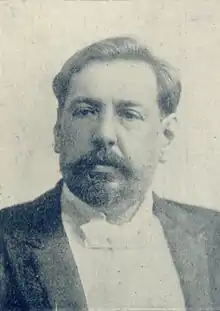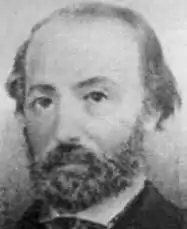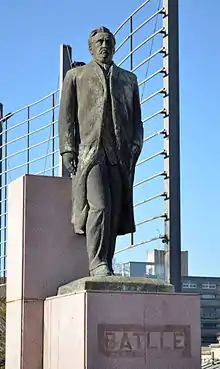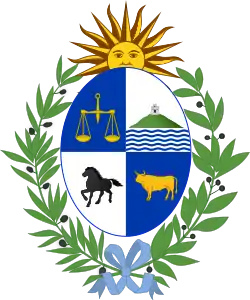José Batlle y Ordóñez
José Pablo Torcuato Batlle y Ordóñez[note 1] (23 May 1856 in Montevideo, Uruguay – 20 October 1929), nicknamed “Don Pepe”, was a prominent Uruguayan politician, who served two terms as President of Uruguay for the Colorado Party. He was the son of a former president and was widely praised for his introduction of the political system Batllismo to South America, and his role in creating the modern Uruguay through his extensive welfare state reforms.
José Batlle y Ordóñez | |
|---|---|
 José Batlle y Ordóñez | |
| 19th and 21st President of Uruguay | |
| In office 1 March 1911 – 1 March 1915 | |
| Preceded by | Claudio Williman |
| Succeeded by | Feliciano Viera |
| In office 1 March 1903 – 1 March 1907 | |
| Preceded by | Juan Lindolfo Cuestas |
| Succeeded by | Claudio Williman |
| In office 5 February 1899 – 1 March 1899 Acting | |
| Preceded by | Juan Lindolfo Cuestas |
| Succeeded by | Juan Lindolfo Cuestas |
| 2nd and 5th Prime Minister of Uruguay | |
| In office 1 March 1921 – 1 March 1923 | |
| President | Baltasar Brum |
| Preceded by | Feliciano Viera |
| Succeeded by | Julio María Sosa |
| In office 1 March 1927 – 16 February 1928 | |
| President | Juan Campisteguy |
| Preceded by | Luis Alberto de Herrera |
| Succeeded by | Luis Caviglia |
| President of the Senate of Uruguay | |
| In office 1899–1900 | |
| Preceded by | Carlos de Castro |
| Succeeded by | Juan Carlos Blanco Fernández |
| In office 1903–1903 | |
| Preceded by | Juan Carlos Blanco Fernández |
| Succeeded by | Juan P. Castro |
| Member of the Senate of Uruguay[1] | |
| In office 9 February 1899 – 5 February 1902 | |
| Constituency | Montevideo Department |
| In office 8 February 1902 – 1 March 1903 | |
| Constituency | Montevideo Department |
| Member of the Chamber of Representatives | |
| In office 15 February 1891 – 14 February 1894 | |
| Constituency | Salto Department |
| Personal details | |
| Born | May 21, 1856 Montevideo, Uruguay |
| Died | October 20, 1929 (aged 73) Montevideo, Uruguay |
| Nationality | Uruguayan |
| Political party | Colorado Party |
| Spouse(s) | Matilde Pacheco |
| Children | César Rafael Lorenzo Amalia Ana Ana Amalia |
| Occupation | Journalist |
Part of a series on the |
|---|
| History of Uruguay |
 |
|
|
In 1898, for a few weeks he served as interim president and later was elected to the presidency for two terms, from 1903 until 1907 and from 1911 to 1915. He remains one of the most popular Uruguayan presidents, in part due to his role as a social reformer. He is known for introducing unemployment compensation, eight-hour workdays, and universal suffrage, as well as free High School education.
Early life and background
Batlle was born on May 23, 1856 in Montevideo to Lorenzo Batlle y Grau and Amalia Ordoñez.[3] Batlle’s grandfather, José Batlle y Carreó, had arrived in Montevideo on his own ship with Batlle’s grandmother from Sitjes, a town near Barcelona, and built a flour mill which won a contract to provision the Royal Spanish Navy in Montevideo. Batlle’s grandfather was loyal to the Spanish crown through both the British invasions of the River Plate and the first and second attempts to secure Uruguayan independence from Spain led by José Gervasio Artigas, and subsequently returned to Spain in 1814, and the rest of the Batlle family followed in 1818. Batlle’s grandmother died in Sitjes in 1823, and his grandfather subsequently returned to Montevideo in 1833 to reopen the flour mill. Batlle’s father Lorenzo had been born in Uruguay in 1810, and returned the Montevideo three years before the rest of the family in 1830, after an extensive education in France and Spain. Batlle’s father quickly joined and became prominent within the Colorados, and was involved in the Uruguayan Civil War, notably personally escorting Fructuoso Rivera to exile in Brazil in 1847. Lorenzo Batlle married Batlle’s mother, the daughter of another Colorado guerrilla, during the Uruguayan Civil War.

The Batlle family were prohombres (prominent figures) within the Colorado Party, with five of Batlle’s relatives serving as president. Batlle’s father Lorenzo had served as Minister of War during the Great Siege of Montevideo, and was elected President of Uruguay in 1868 when Batlle was 12 years old. Batlle's children César, Rafael and Lorenzo were actively engaged in politics, with César and Lorenzo serving in . He was also the uncle of another Uruguayan President, Luis Batlle Berres and the great-uncle of President Jorge Batlle, and his uncle-in-law Duncan Stewart served as acting president for three weeks in 1894.
After attending school at an English school in Montevideo, Batlle studied at the University of the Republic.[4] At university, he became involved in the discussions and debates between the ‘idealists’ and ‘positivists’. Led by Prudencio Váquez y Vega, Batlle was a prominent member of the idealists. Batlle’s political ideology was influenced by the work of philosopher Heinrich Ahrens, whose work was introduced to Batlle by Váquez y Vega. In 1880, a 24-year-old Batlle convinced his father to let him study for a year in Paris, where he took a course in English and sat in on philosophy lectures before returning home when money ran out.
Batlle was a prominent journalist, and founded El Día newspaper in 1886. Batlle used his newspaper as a political platform for criticizing his opponents and promoting his reformist agenda.
He served as the President of the Senate of Uruguay from 1899 to 1900, and in 1903.[1]
Presidency
Revolution of 1904
In 1904 Batlle's government forces successfully ended the intermittent Uruguayan Civil War which had persisted for many years, when the opposing National Party leader Aparicio Saravia was killed at the battle of Masoller. Without their leader, Saravia's followers abandoned their fight, starting a period of relative peace.
Social reforms
During Batlle y Ordóñez's term in office, secularization became a major political issue. Uruguay banned crucifixes in hospitals by 1906, and eliminated references to God and the Gospel in public oaths. Divorce laws were also established during this time. He led Uruguay's delegation to the Second Hague Conference and was noted for his peace proposals there.[5] Much of the time between his two terms Batlle spent travelling in Europe and picking up ideas for new political and social reforms, which he introduced during his second term.
Second term
In 1913, influenced by visiting and studying French and Swiss politics between his first and second terms, Batlle proposed a reorganization of the government which would replace the presidency with a nine-member National Council of Administration, similar to the Swiss Federal Council.[6] Batlle’s proposal for a collective leadership body was defeated in 1916 referendum, but he managed to establish a model in which executive powers were split between the Presidency and the National Council of Administration when a variant of his proposal was implemented with the Constitution of 1918.
Economy
During Batlle's second term, he began a new movement and referred to as Batllismo: concerted state action against foreign economic imperialism. During this time he fought for such things as unemployment compensation (1914), eight-hour workdays (1915), and universal suffrage. As President, Battle introduced a wide range of reforms in areas such as social security and working conditions.
All of this brought a great government involvement into the economy. Private monopolies were turned into government monopolies and tariffs were imposed on foreign products, including machinery and raw material imports. The growth of the meat processing industry stimulated the livestock industry, Uruguay's main source of wealth.
Education
Education started a process of great expansion since the mid-to-late 19th century. It became the key to success for the middle class community. The state approved free high school education and created more high schools through the country. The university was also opened to women, and the enrollment increased throughout the country.
Later life
In early 1920 Batlle killed Washington Beltrán Barbat, a National Party deputy, in a formal duel that stemmed from vitriolic editorials published in Batlle's 'El Día' newspaper and Beltrán's 'El País'.[7] His son Washington Beltrán would become President of Uruguay. He also served twice as Chairman of the National Council of Administration (1921-1923, 1927-1928).
Legacy
Batlle is commonly explained as being “ahead of his times.” He was more than ahead of his times. Batlle created his times. His success reminds us that a man’s ideals can lead other men.
— Milton I. Vanger, José Batlle y Ordoñez of Uruguay: The Creator of His Times 1902 – 1907, page 274

The first implementation of the colegiado system which Batlle had championed, the National Council of Administration, was overthrown in a coup by president Gabriel Terra in 1933 and abolished by the third Constitution of Uruguay in 1934, a little over four years after Batlle’s death. The idea of the colegiado system remained influential, however, and was reintroduced with the 1952 Constitution of Uruguay in the form of the National Council of Government (Uruguay). The National Council of Government fully abolished the presidency, making it closer to Batlle’s desired system, but was itself abolished for a second time and the presidency re-established by the 1967 constitution.
A public park and a neighborhood in Montevideo are named after him.
There is also a town in Lavalleja Department named after him.
See also
Notes
References
- Parlamentarios Uruguayos 1830-2005 2013, p. 390.
- Vanger 1963, p. 287.
- Vanger 1963, pp. 18–20.
- Vanger 1963, pp. 21–22.
- The Independent 1914.
- Altman 2008, pp. 488–494.
- The New York Times 1920a; The New York Times 1920b.
Bibliography
- Altman, David (2008). "Collegiate Executives and Direct Democracy in Switzerland and Uruguay: Similar Institutions, Opposite Political Goals, Distinct Results". Swiss Political Science Review. 14 (3): 483–520. doi:10.1002/j.1662-6370.2008.tb00110.x.
- Barrán, José P.; Nahum, Benjamín (1979). Batlle, los Estancieros y el Imperio Británico (in Spanish). Montevideo: Ediciones de la Banda Oriental.
- Grompone, Antonio M. (1984). La Ideología de Batlle (in Spanish). Montevideo: Librosur.
- Hoover, John (1963). "Jose Batlle y Ordonez of Uruguay, the Creator of His Times, 1902-1907". The Western Political Quarterly. 16 (4). doi:10.2307/445874. JSTOR 445874.
- "A Basis for a League of Peace". The Independent. July 20, 1914. Retrieved August 21, 2012.
- Knarr, James Charles (2009). Batllismo and the Yankees: The United States and Uruguay, 1903–1929 (PhD). Ann Arbor, United States. ProQuest 288388292 – via ProQuest.
- Knarr, James C. (2011). "Uruguay's José Batlle y Ordóñez: The Determined Visionary, 1915 – 1917". Book Review. The Hispanic American Historical Review. 91 (2): 365–367. doi:10.1215/00182168-1165406.
- Knarr, James C. (2012). Uruguay and the United States, 1903–1929: Diplomacy in the Progressive Era. Kent, Ohio: Kent State University Press. doi:10.21038/ksup.2012.0015. ISBN 978-1-60635-128-4.
- Martin, Percy Alvin (1930). "The Career of José Batlle y Ordóñez". The Hispanic American Historical Review. 10 (4): 413–428. doi:10.2307/2518448. JSTOR 2518448.
- Merquior, J. G. (1983). "Radical Reformism in the Pampas: the case of Batllismo". Review. Government and Opposition. 18 (1): 120–124. doi:10.1017/S0017257X00018170. JSTOR 44483474.
- "Ex-President of Uruguay Kills Editor In Formal Duel Fought With Pistols". The New York Times. Associated Press. 3 April 1920. p. 15.CS1 maint: date and year (link)
- "Formal and Fatal Duel". The New York Times. 16 May 1920. p. 117.CS1 maint: date and year (link)
- Parker, David S. (2010). "Uruguay's José Batlle y Ordóñez: The Determined Visionary, 1915- 1917 by Milton I. Vanger". Reviews: Politics & Governance. The Americas. 67 (2): 273–275. JSTOR 40929651.
- Pendle, George (1963). "José Batlle y Ordóñez of Uruguay: The Creator of his Times. 1902–1907". Reviews. International Affairs. 39 (4): 654. doi:10.2307/2609295. JSTOR 2609295.
- Peterson, Lars Edward (2014). In the Shadow of Batlle: Workers, State Officials, and the Creation of the Welfare State in Uruguay, 1900–1916 (PDF) (PhD).
- Presidencia de la Asamblea General y del Sendado; Presidencia de la Camara de Representantes (October 29, 2013). "Parlamentarios Uruguayos 1830-2005" (PDF). www.parlamento.gub.uy (in Spanish). Archived from the original (PDF) on October 29, 2013.
- Street, John (1964). "M. I. Vanger, "José Batlle y Ordóñez of Uruguay. The creator of his times. 1902-1907"". Book Review. Bulletin of Hispanic Studies. 41 (3): 201. doi:10.3828/bhs.41.3.206.
- Taylor Jr., Philip B. (1963). "José Batlle y Ordóñez of Uruguay. The Creator of His Times, 1902-1907". Book Review. Hispanic American Historical Review. 43 (4): 577–579. doi:10.1215/00182168-43.4.577.
- Van Aken, Mark (1981). "The Model Country: José Batlle y Ordóñez of Uruguay, 1907-1915". Book Review. The Hispanic American Historical Review. 61 (4): 774–775. doi:10.1215/00182168-61.4.774.
- Vanger, Milton I. (1963). José Batlle y Ordoñez of Uruguay: The Creator of His Times 1902 – 1907. Cambridge, Massachusetts: Harvard University Press. LCCN 62-19225.
- Vanger, Milton I. (1980). The Model Country: José Batlle y Ordoñez of Uruguay, 1907-1915. Hanover, New Hampshire: Brandeis University Press. ISBN 0874511844.
- Vanger, Milton I. (2010). Uruguay's José Batlle y Ordóñez: The Determined Visionary, 1915-1917. Boulder, Colorado: Lynne Rienner Publishers. ISBN 9781588266941.
External links
| Wikimedia Commons has media related to José Batlle y Ordóñez. |
- "Batllism".
- "Batlle y Ordoñez and the Modern State". 1990.
- Henderson, James D.; Henderson, Alexander C.; Delpar, Helen; Brungardt, Maurice Philip; Weldon, Richard N. (2000). Reforms in the era of Battlism. ISBN 9781563247446.
| Political offices | ||
|---|---|---|
| Preceded by Juan Lindolfo Cuestas |
President of Uruguay Acting 1899 |
Succeeded by Juan Lindolfo Cuestas |
| Preceded by Juan Lindolfo Cuestas |
President of Uruguay 1903–1907 |
Succeeded by Claudio Wílliman |
| Preceded by Claudio Wílliman |
President of Uruguay 1911–1915 |
Succeeded by Feliciano Viera |
| Preceded by Feliciano Viera |
Prime Minister of Uruguay 1921–1923 |
Succeeded by Julio María Sosa |
| Ancestors of José Batlle y Ordóñez | ||||||||||||||||||||||||||||||||||||||||||||||||||||||||||||||||||||||||||||||||||||||||||||||||||||||||||||||||||||||||||||||||||||||||||||||||||||||||||||||||||||||||||||||||||||||||||||||||||||||||||||||||||||||||||||||||||||||
|---|---|---|---|---|---|---|---|---|---|---|---|---|---|---|---|---|---|---|---|---|---|---|---|---|---|---|---|---|---|---|---|---|---|---|---|---|---|---|---|---|---|---|---|---|---|---|---|---|---|---|---|---|---|---|---|---|---|---|---|---|---|---|---|---|---|---|---|---|---|---|---|---|---|---|---|---|---|---|---|---|---|---|---|---|---|---|---|---|---|---|---|---|---|---|---|---|---|---|---|---|---|---|---|---|---|---|---|---|---|---|---|---|---|---|---|---|---|---|---|---|---|---|---|---|---|---|---|---|---|---|---|---|---|---|---|---|---|---|---|---|---|---|---|---|---|---|---|---|---|---|---|---|---|---|---|---|---|---|---|---|---|---|---|---|---|---|---|---|---|---|---|---|---|---|---|---|---|---|---|---|---|---|---|---|---|---|---|---|---|---|---|---|---|---|---|---|---|---|---|---|---|---|---|---|---|---|---|---|---|---|---|---|---|---|---|---|---|---|---|---|---|---|---|---|---|---|---|---|---|---|
| ||||||||||||||||||||||||||||||||||||||||||||||||||||||||||||||||||||||||||||||||||||||||||||||||||||||||||||||||||||||||||||||||||||||||||||||||||||||||||||||||||||||||||||||||||||||||||||||||||||||||||||||||||||||||||||||||||||||
